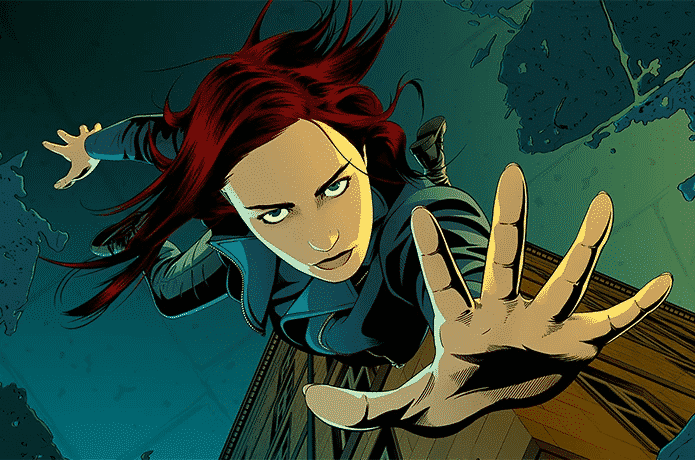Viking Metal Meets 90s Image in ‘Bloodrik’. If you’re a fan of metal, 90s comics, and spilled barbarian blood, then you definitely should check out Bloodrik. Created by Andrew Krahnke, Bloodrik originally started as an ashcan that Krahanke sold at cons. Now, it is a three-part series from Image Comics! In the following interview, Andrew explains what exactly is Bloodrik, and why he’s embarking on a journey of madness, violence, fire, and BLOOD!
Bloodrik is a three-issue miniseries that tells the story of a hungry, desperate woodsman whose confidence is shaken when he can’t find food in his usual hunting grounds. It’s about the lengths he’ll go to in order to fill his stomach and heal his wounded ego. The issues are around 40 pages and they feature all-new backup stories in each issue.
It’s creator, Andrew Krahnke is an illustrator and comic artist originally from Michigan’s Upper Peninsula currently living on Long Island.
“I got really into Viking metal a while ago and started sketching barbarians and Viking stuff just for fun. Bloodrik kind of came out of that. I wanted to draw a Viking metal/power metal-inspired comic with a huge guy trudging across a frozen wasteland, so I built the story of the comic around that visual idea. Bloodrik was also fairly heavily inspired by the Rob Liefeld and Stephen Platt comics I loved growing up.
I grew up reading my dad’s old comics and MAD magazines at my grandparent’s house, and we always had Far Side and Calvin and Hobbes books around. I’d read those every morning while eating cereal. My older brother is a huge comics reader so I was constantly exposed to his collection, mostly Spider-Man, X-Men, and other late 80s/early 90s Marvel stuff. Also, [1989’s] Batman had come out not too long before that which I loved and my folks bought me some Batman comics. Then when the Teenage Mutant Ninja Turtles hit I was obsessed with them and that was the first comic I ever sought out and collected – the Archie ones, actually (Teenage Mutant Ninja Turtles Adventures). That was also around the time Image was starting and I got really into Rob Liefeld’s stuff. Honestly, if you were 10-years-old in 1990-91 I don’t know how you didn’t get into comics.
I was always “the kid who drew a lot” in high school, and drawing was always something I wanted to do. I attended the Kubert school and graduated from there in 2002. Not long after that, a friend got me a job at a design company drawing everything from candy packaging and coloring books to toy designs and company logos. It was great because it really made me work and stretch my drawing skills, which was perfect for a young illustrator. And actually, the bulk of my daily work is still from clients I worked with at that job.
I was always working on comic ideas though, and I’d post sketches and stuff online. From that, I was lucky enough to meet and have the opportunity to work with some great writers on some fun comic projects including The Outrunners with Jonathan Gelatt and the second arc of Tartarus with Johnnie Christmas. In between those two projects I wrote, drew, and self-published a Bloodrik ashcan that I sold online and at the Small Press Expo. It got a decent response and eventually, I was given the opportunity to have the whole story published through Image, which has been awesome.
Most of the time I’m using an old-school 0.5 Pentel Twist-Erase, the original version before they added the garbage padded grip to them. It’s the pencil I got used to using in high school and I’ve never gotten away from it. I also use a 0.3 Pentel 120 A3 quite a bit. When I’m inking I usually use Microns or Prismacolor fine liners. And I usually color everything in Photoshop.
I didn’t actually ink anything for Bloodrik. I just tightly penciled the pages, darkened and cleaned them up in Photoshop, and then colored them. I drew the pages on cheap, 11×17 store-brand typing paper since it was easier to keep clean and get a sharp line on it as opposed to a higher-quality bristol board.”
Viking metal is a subgenre of heavy metal music characterized by a lyrical and thematic focus on Norse mythology, Norse paganism, and the Viking Age. Viking metal is quite diverse as a musical style, to the point where some consider it more a cross-genre term than a genre, but it is typically heard as black metal with influences from Nordic folk music. Common traits include a slow-paced and heavy riffing style, anthemic choruses, use of both sung and harsh vocals, a reliance on folk instrumentation, and often the use of keyboards for atmospheric effect.
Viking metal emerged from black metal during the late 1980s and early 1990s, sharing with black metal an opposition to Christianity, but rejecting Satanism and occult themes in favor of the Vikings and paganism. It is similar, in lyrics, sound, and thematic imagery, to pagan metal, but pagan metal has a broader mythological focus and uses folk instrumentation more extensively.












